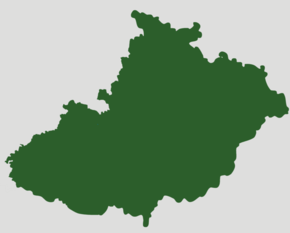Moravia-Silesia
This article needs more links to other articles to help integrate it into the encyclopedia. (May 2024) |
This article contains information pertaining to a simulationist micronation, micronationalist or other element of micronational society or culture. |
Moravian-Silesian Republic | |
|---|---|
| Motto: Genius Loci | |
| Anthem: Moravo, Moravo | |
 | |
| Capital | Olomouc |
| Largest city | Brno |
| Official languages | moravian |
| Demonym(s) | Moravian-Silesian |
| Government | Republic |
| Legislature | Assembly of the Moravian-Silesian Republic |
| Population | |
• Census | 4.000.000 |
| Currency | Moravian-Silesian Kirat |
Website moravskoslezskar.cz | |
Moravia-Silesia (Moravskoslezsko, long form Moravian-Silesian Republic) is an inland micronation in Central Europe, bordering Poland, Slovakia, Austria, and the Czechia. The capital city is Olomouc, while Ostrava is the largest city. Other major cities include Brno, Zlín, Havířov, and Opava.
On May 1, 2012, the State of Moravia was established as the first Moravian micronation. From 2014 to 2017, it was a member of several federations. The Moravian Republic was formed in 2017, later becoming the Moravian-Silesian Republic in 2018.
Moravia-Silesia has been a member of the Society of Micronations since its formation (with predecessors joining in 2016). It operates as a parliamentary democracy with democratic institutions. Moravia-Silesia maintains particularly strong diplomatic ties with Mekniy and Lurk, among other micronations.
History
In May 2011, the first Moravian micronation, the State of Moravia, was founded near the town of Šumperk. Initially focused on the Moravian region, it later expanded its influence to encompass Silesia. In the summer of 2012, Moravia lost its independence and became part of the renewed USSR, and subsequently, Czechoslovakia.
However, in the summer of 2017, growing national tensions in Czechoslovakia led to the dissolution of the federation. While the Czech Socialist Republic and Slovak Socialist Republic were dissolved, the Moravian Socialist Republic transformed into the Moravian Republic.
In 2018, the republic faced challenges regarding national and linguistic identity, administrative organization, and political participation. To address these issues, the Moravian-Silesian Republic was officially formed on October 28, 2018, with the adoption of the Constitution.
Since January 2022, Moravia-Silesia has undergone significant territorial reforms, expanding from 47 counties to 50 counties, and integrating smaller municipalities for more efficient governance. Additionally, the micronation has implemented comprehensive economic reforms aimed at increasing self-sufficiency through cooperative-based economies and strengthening ties with other micronations in Europe.
Political System
According to the updated 2024 Constitution, Moravia-Silesia remains a parliamentary democratic republic. The president is the ceremonial head of state, while executive power is vested in the government led by the prime minister. The prime minister and cabinet members are appointed by the president, but they require a vote of confidence from the Assembly of the Moravian-Silesian Republic, which serves as the unicameral legislative body.
The Assembly has 51 members elected every five years (changed from four years in previous constitutions), reflecting the will of the citizens of Moravia-Silesia. It holds the power to enact laws, approve budgets, and supervise the government's performance.
Economic Reforms
Since 2022, Moravia-Silesia has implemented a series of economic reforms to modernize its economy. These include the establishment of cooperative industries, fostering green technology development, and promoting innovation. These reforms aim to reduce reliance on external resources and emphasize sustainable development and digital transformation.
Territorial Division
As of September 2024, Moravia-Silesia is administratively divided into 50 counties (previously 47), which are further subdivided into municipalities. Counties and municipalities serve as self-governing entities managed by county and local committees, known as national committees. These reforms have been implemented to improve local governance efficiency, especially in more remote and rural areas.
The administrative regions now focus on providing better services, particularly in health care, education, and infrastructure development, while preserving the cultural diversity of the Moravian and Silesian regions.

